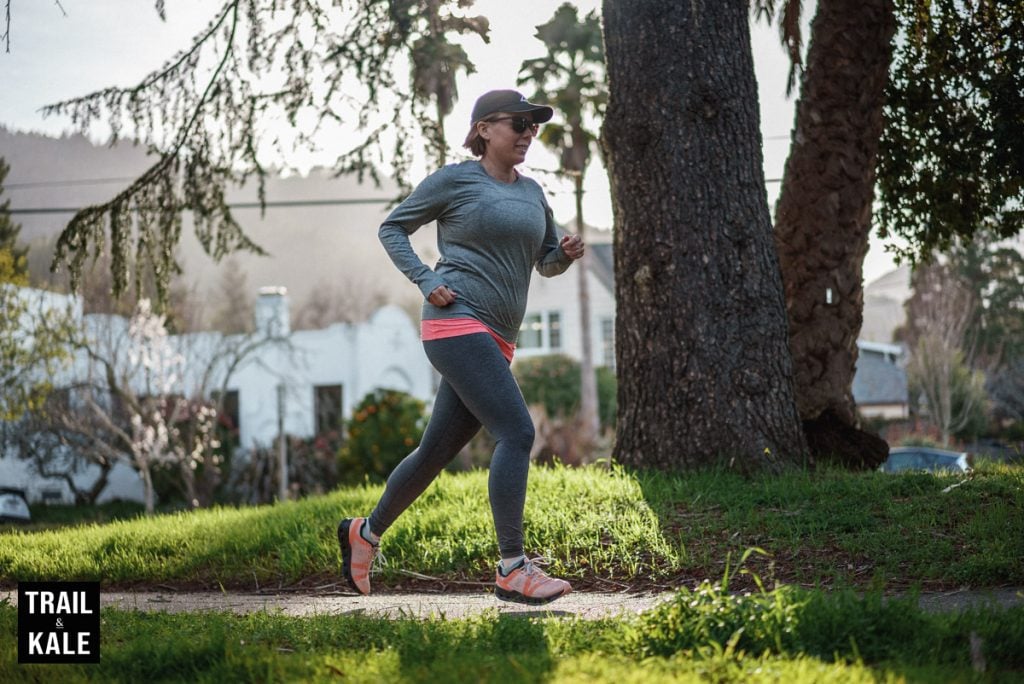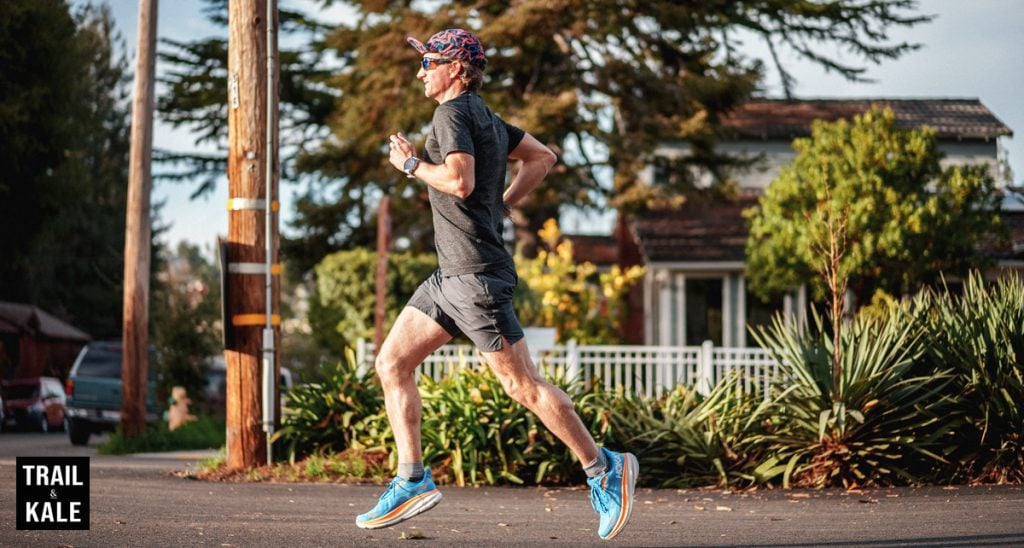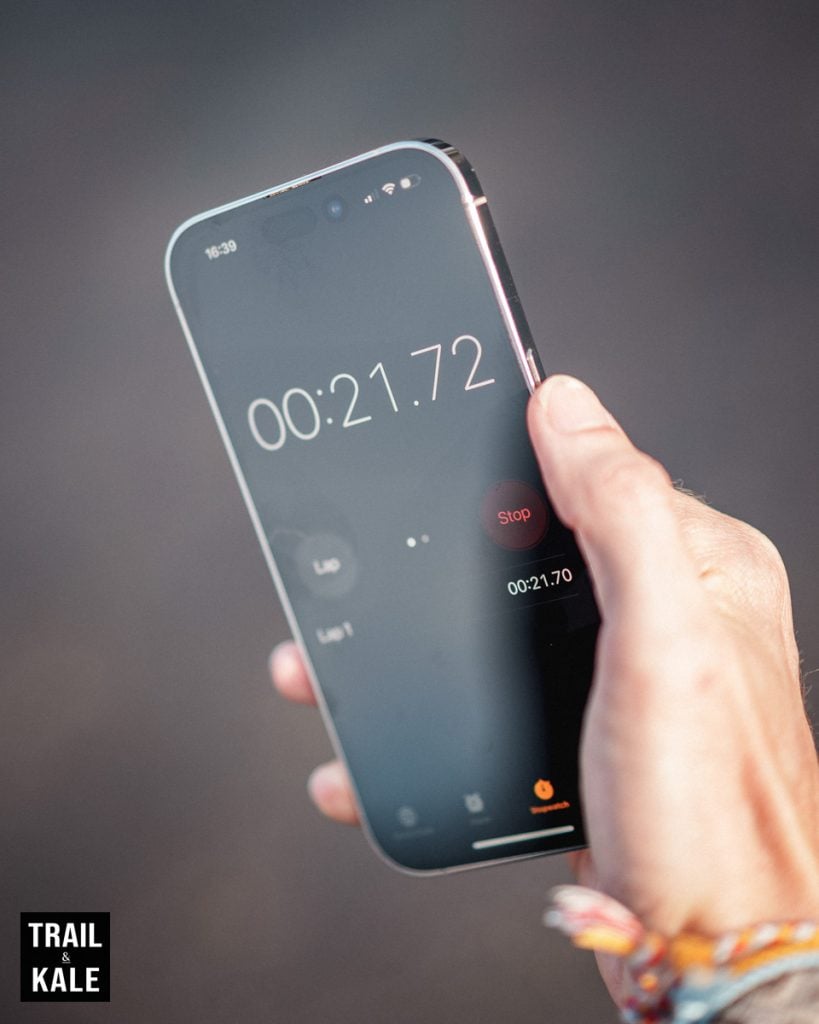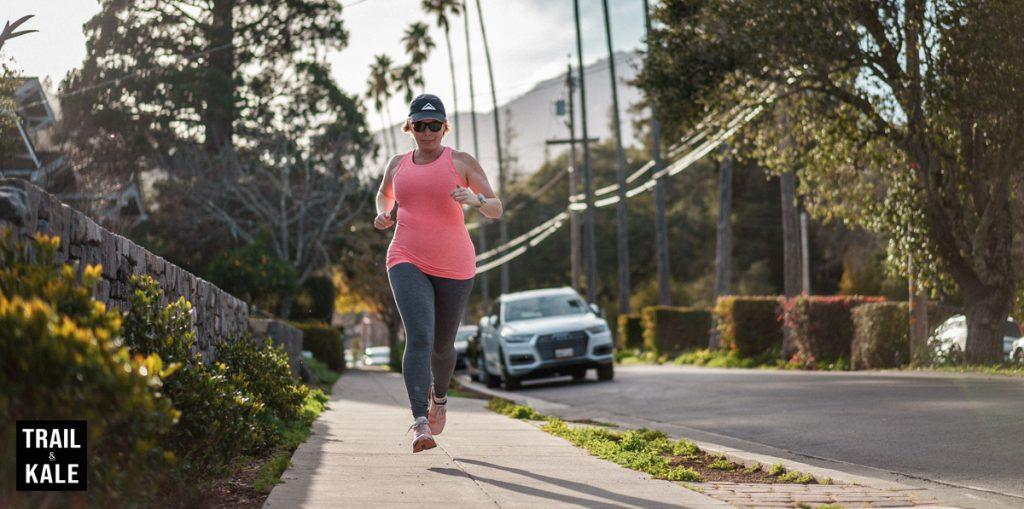Helen here from Trail & Kale, and in this post I’m covering running cadence. What is running cadence? Put simply, cadence is the number of steps you take per minute while running, and it can have a big impact on your running form, efficiency, and injury risk.
In this post, I explain the importance of cadence in running, how to work out your own cadence, why you may be heel striking and overstriding, and the reasons why your cadence may be affecting your running speed, efficiency, form, and risk of running-related injuries such as shin splints, ITB pain and Achilles tendinitis.
I also explain how making relatively small changes to your running cadence can have a significant impact on your running performance and include several of my favorite tips to improve your running cadence and overall running form, whether you’re just getting started in running, or you’ve been doing it for a while.

Understanding the relationship between running cadence and stride length
While cadence refers to the number of steps taken per minute, stride length is the distance covered by each step. Therefore it’s the combination of running cadence (aka stride rate) and stride length that determines how fast you run.
Typically, recreational runners with a higher cadence take shorter strides, while runners with a lower cadence take longer strides.
That being said, if you watch elite runners on the track running the 5,000m or 10,000m (i.e. 5k or 10k), and work out their cadence (by counting their steps – I explain how to do this later in this post), you’ll see that not only do they tend to have a higher cadence, but their stride length is also long.
Elite athletes run so efficiently and with such good biomechanics and power that they’re able to take these large strides but still maintain a fast jogging cadence and good form, without over striding, which is one of the reasons why they’re able to achieve such impressive speeds!
In case you were wondering, other factors that contribute to an elite runner’s speed include their VO2 max, lactate threshold, and running economy, which are also all things recreational runners can work on to be able to run faster, too.
Why is cadence important for running?
Maintaining an appropriate cadence and stride length is important for efficient and injury-free jogging.
Many runners with a slow cadence will tend to take long strides, which can increase the impact on your joints and lead to overstriding (more on that, later).
However, runners with a cadence that is too high that take short strides, can cause excessive muscle fatigue and reduce running efficiency.
Finding the right balance between cadence and stride length for your body and running style can help you run more comfortably, with better form and lower injury risk.
What is a good running cadence?

A widely-considered view among runners and running coaches tends to be that a good running cadence is somewhere in the region of 180 steps per minute.
However, a runner’s cadence of 180 is not a one size fits all recommendation, more of a guideline, so it’s best not to get too hung up on your actual steps per minute. Many runners have great running form but their cadence is a little slower or faster than 180.
Other considerations to take into account are that taller runners won’t be taking as many steps per minute as shorter runners because their stride length is much longer.
Personally, I run at around a 170 cadence for runs up to around half marathon distance. On those tough long runs of more than a few hours, like most runners, my stride rate tends to get slower as my body gets more fatigued.
The trick to finding the optimal cadence for you is to find one that ensures you’re running efficiently, with good form and a consistent jogging pace, and this may need to change depending on the distance you plan to run.
How the run distance and terrain affect running cadence
In general, when people run longer distances like those undertaking marathon training and ultramarathon runners tend to have lower cadence rates due to the increased physical demand for endurance over a long period of time.
For example, during a 5k race, the ideal cadence rate for most runners may be between 170-190 steps per minute, while during a marathon, a cadence rate of 160-170 is more common.
During an ultramarathon, cadence rates can vary widely depending on the terrain, length of the race, and individual runners’ preferences and capabilities.
If you’re unfamiliar with ultramarathons, it’s worth noting that the majority of runners, including the elite runners, are likely to walk for parts of their race, for reasons that may include them experiencing a wave of fatigue, because they’re eating on the go, or because it’s more efficient to walk at certain points in a race, such as when heading up a steep hill.
Therefore an ultra runner’s average cadence over the race course decreases to a much slower rate to reflect the walking speed.
Additionally, it’s worth knowing that trail runners generally tend to have a faster cadence when trail running over trickier flat terrain, and many ultramarathons are run on trails rather than pavement, so it’s sometimes hard to make comparisons between cadence measured for road runners and trail runners.
This is another reason why you shouldn’t get hung up on achieving a particular stride rate, all the time.
Trail running cadence will likely be lower on average, depending on the route taken because there are going to be sections of steep uphills which of course reduces it. For tips on running uphill faster and more efficiently, read our guide to running uphill.
How do you work out your running cadence?

To work out your current running cadence, count the number of times your right (or left – pick one) foot hits the ground in a minute while jogging, then double the number.
You can use the stopwatch app on your phone (or watch, if you have a smartwatch like an Apple Watch) to time the 60 seconds.
Alternatively, all of these running watches do a great job of keeping track of your cadence during your runs – for the whole run, which is useful data if you want to see how it changes over time throughout your run, and from run-to-run if you’re actively working on trying to improve it.
If you’re on more of a budget, a less expensive running watch like the Coros Pace 2 will also do that for you.
Some runners will naturally have that golden 180 spm (strides per minute) – if that’s you, congrats, you’re probably already jogging very efficiently!
Drop a comment below telling us what your average cadence was when you checked it!
What is over striding and how do you know if you do it?
Overstriding in running is when distance runners run with a longer stride than their natural stride length, causing their foot to land in front of their center of mass.
This is often referred to as heel striking, because your heel will end up hitting the ground in front of you, just before the rest of your foot does.
This results in a braking effect, which can increase the impact on the joints, lead to greater muscle fatigue, and reduce running efficiency.
Because of this impact and inefficient running technique, overstriding can increase the risk of injuries such as shin splints, IT band syndrome, and knee pain.
Do you need to increase your cadence for running faster?
Examine your running technique – which is easiest done if you film yourself jogging, or ask a friend to observe you as you run. If you ask nicely, perhaps they’ll also count your strides for a minute and work out your stride rate for you 🙂
If you suspect your strides per minute is higher than it should be (either because you checked and you know you tend to take long, slow strides, or because you suffer from these running issues) then it may be time to do some work to increase your running cadence so you can run with, shorter, more frequent strides, and with less impact o your joints.
How to change your running cadence
If you’re looking to improve your running cadence, here are four simple ways to work on changing your stride frequency.
Run to music with 180 bpm running cadence songs

My personal favorite way to check in with my running stride during running technique sessions is to find a playlist on Apple Music or Spotify that has songs that play at 180 beats per minute, put my favorite wireless headphones on, and run to the beat.
Use a metronome
A metronome is a great tool for measuring cadence, and I don’t mean the one you used to keep your piano playing in-time.
You can download a metronome (or beep) app such as Smart Metronome, set it to 90 beats per minute, and ensure your right foot (or left foot – pick one) lands on the beat each time. If you have a good running watch then many of these watches will also have this option which you can program in to use on your next training run.
This method is best done if you can use headphones or be somewhere with no other people around, as the beeping will probably get annoying for other runners and people around you :-).
If you need some headphones suitable for running that won’t fall out of your ears, these are the best headphones for running right now.
Try barefoot running
Find somewhere suitable where you can run outdoors either barefooted (such as a sand beach or grassy area) or with minimalist running shoes that have a very low, or ideally zero drop.
You’ll quickly discover that when you start to do barefoot running that your body adapts and will want you to run with a forefoot to mid-foot landing so it’s more comfortable for you and minimizes the impact of your foot striking the ground.
For many people, this means you’ll have a higher cadence as you run compared to your usual cadence when you run in your regular running shoes.
Although barefoot running (and running with zero-drop shoes) isn’t for everyone, it’s an interesting lesson in learning what our ‘natural’ stride rate should be.
We see so many new runners running in shoes with a high ‘stack’ and heel-to-toe drop, which, while cushioned (which sounded appealing when you bought them), actually encourage you to heel strike in some cases!
So, if you feel you may run more effectively and with less heel striking in shoes with a lower drop, next time you need a new pair of running shoes look for some that have a drop of between 4mm and 8mm, like many of the shoes you’ll find on our best running shoes buyer’s guide.
Run on a treadmill
It’s generally harder to run with a slow cadence on a treadmill. So, try some treadmill runs and see how your cadence changes, especially if you do some running intervals on the treadmill at higher speeds.
Alternatively, to get your body set up to run outdoors, if you have access to a treadmill, you can also try jogging on it for 3-5 minutes, check your cadence as you do so, then head outside and try to run with a similar cadence outdoors while you still remember what it feels like!
What happens when you increase your running cadence?

Your first runs at this new (and for most people, faster) cadence may be at a slower overall running speed than the speed you’re used to jogging at. This is normal, and to be expected. Don’t panic, you’ll get the speed back… and then some!
You need to re-train your body and muscle memory to run at this new, and for most runners, higher running cadence than what you were previously used to.
However, over time, you’ll find that you can start running at a faster pace, while being disciplined enough to keep your cadence the same.
How? Because the next steps (if you’ll pardon the pun), are to work on your explosive power and strength, as well as building up your aerobic capacity (VO2 max) so you can sustainably increase your stride length while jogging at your target cadence!
Tips for increasing running stride length
Your ability to run at a faster pace with this new cadence is dependent on two factors – your cardio levels, and your strength (primarily in your legs and glutes, but also your arms, back and core play a part).
Here are some things you can do to train your body to run faster:
- Interval training – including tempo runs, speed intervals and fartlek training. Doing interval training is the single most efficient way most runners can work to increase their speed, with results in a matter of weeks.
- Improve your running form – here are some ways to move towards proper running form for better running economy, efficiency and a generally lower propensity to suffer from running-related injuries.
- Breathe properly – here are some tips to improve how you breathe while running to improve oxygen intake and performance.
- Cross training – including plyometric drills and resistance training with weights or using your body weight, such as squats and lunges.
- Heart rate zone training – heart rate zone training has numerous benefits, including improving your ability to tune into your body more effectively and tracking your body’s effort levels during everything from those long, slow training runs to understanding how your body is responding to those intensive interval training sessions.
For tips to increase your running speed as well as becoming an overall stronger runner with quicker recovery times, read our post entitled ‘How To Run Faster‘, next.
Keep in mind that improving your running cadence takes time and practice, but the benefits are worth it! Don’t be discouraged if it feels difficult at first – with consistent effort, you’ll start to see progress.
And don’t forget to share your own tips for improving cadence with the Trail & Kale community in the comments below! We’d love to hear from you.








